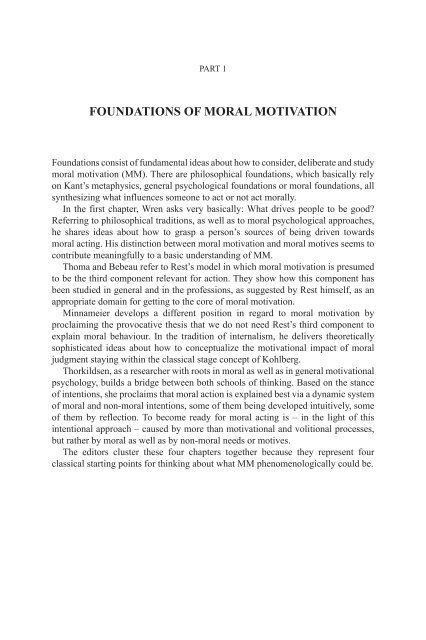Handbook of moral motivation: Theories, models ... - Sense Publishers
Handbook of moral motivation: Theories, models ... - Sense Publishers
Handbook of moral motivation: Theories, models ... - Sense Publishers
- No tags were found...
You also want an ePaper? Increase the reach of your titles
YUMPU automatically turns print PDFs into web optimized ePapers that Google loves.
PART 1FOUNDATIONS OF MORAL MOTIVATIONFoundations consist <strong>of</strong> fundamental ideas about how to consider, deliberate and study<strong>moral</strong> <strong>motivation</strong> (MM). There are philosophical foundations, which basically relyon Kant’s metaphysics, general psychological foundations or <strong>moral</strong> foundations, allsynthesizing what influences someone to act or not act <strong>moral</strong>ly.In the first chapter, Wren asks very basically: What drives people to be good?Referring to philosophical traditions, as well as to <strong>moral</strong> psychological approaches,he shares ideas about how to grasp a person’s sources <strong>of</strong> being driven towards<strong>moral</strong> acting . His distinction between <strong>moral</strong> <strong>motivation</strong> and <strong>moral</strong> motives seems tocontribute meaningfully to a basic understanding <strong>of</strong> MM.Thoma and Bebeau refer to Rest’s model in which <strong>moral</strong> <strong>motivation</strong> is presumedto be the third component relevant for action . They show how this component hasbeen studied in general and in the pr<strong>of</strong>essions, as suggested by Rest himself, as anappropriate domain for getting to the core <strong>of</strong> <strong>moral</strong> <strong>motivation</strong>.Minnameier develops a different position in regard to <strong>moral</strong> <strong>motivation</strong> byproclaiming the provocative thesis that we do not need Rest’s third component toexplain <strong>moral</strong> behaviour. In the tradition <strong>of</strong> internalism , he delivers theoreticallysophisticated ideas about how to conceptualize the <strong>motivation</strong>al impact <strong>of</strong> <strong>moral</strong>judgment staying within the classical stage concept <strong>of</strong> Kohlberg.Thorkildsen, as a researcher with roots in <strong>moral</strong> as well as in general <strong>motivation</strong>alpsychology, builds a bridge between both schools <strong>of</strong> thinking. Based on the stance<strong>of</strong> intentions, she proclaims that <strong>moral</strong> action is explained best via a dynamic system<strong>of</strong> <strong>moral</strong> and non-<strong>moral</strong> intentions, some <strong>of</strong> them being developed intuitively, some<strong>of</strong> them by reflection . To become ready for <strong>moral</strong> acting is – in the light <strong>of</strong> thisintentional approach – caused by more than <strong>motivation</strong>al and volitional processes,but rather by <strong>moral</strong> as well as by non-<strong>moral</strong> needs or motive s.The editors cluster these four chapters together because they represent fourclassical starting points for thinking about what MM phenomenologically could be.














